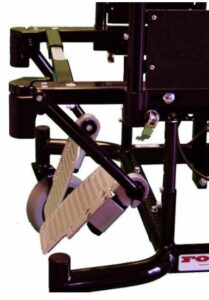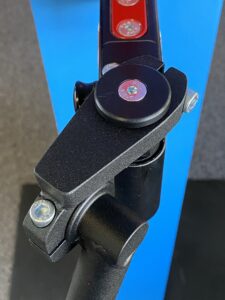Static Wheelchair Footrests: special circumstances
Michelle L. Lange, OTR/L, ATP/SMS
Seating Dynamics is all about Dynamic Seating components. However, we also make static footrests. Why? Don’t static footrests come standard on wheelchairs anyway?

Super Contracture Option
Why does the world need another static footrest hanger?
While manual and power wheelchairs come with a variety of available footrests, standard footrests do not meet the needs of everyone. Footrest placement is sometimes limited by client range of motion loss and orthopedic asymmetries, particularly when the hamstrings are very tight. If range of motion limitations or orthopedic asymmetries prevent the client’s foot from being in alignment with a standard footrest and footplate, our static footrests can accommodate a variety of positional needs.
The dimensional setup of the wheelchair frame can impact footrest placement, as well. Seat to floor height, seat width, seat depth, leg length, caster size, orientation in space of the seating system, and anything consuming space in the area of the footrests must be considered, as these all have the potential to limit proper positioning.
How are Seating Dynamics Static Footrests Different?
Knee Angle. Standard footrests are available at angles of 90, 80, 70, and 60. Our static footrest adjustable knee joint allows unlimited adjustment in 7.5 degree increments. For clients with very tight hamstrings, our adjustable super contracture option supports the feet behind the distal end of the seat – accommodating more knee flexion than a 90 degree footrest.
Ankle Angle. Standard footrests sometimes offer adjustment into plantar and dorsiflexion at the ankle. Our adjustable plantar/dorsi flexion joint provides adjustment in 7.5 degree increments and, more importantly, maintains that position.

Adjustable Windswept Joint
Windswept Tendency. Some clients demonstrate a windswept tendency, where one leg is adducted and internally rotated and the other leg is abducted and externally rotated due to range limitations at the hips. In this scenario, if the legs are pulled into a more aligned position, the pelvis will rotate. It is critical to position the pelvis in neutral and allow this windswept posture of the legs. The adjustable windswept joint accommodates a windswept tendency – this joint can be used to accommodate bilateral hip adduction or abduction, as well.
Lower Leg Depth. Standard footrests offer height adjustment of the footplate to match a client’s lower leg length. Sometimes a shorter or longer height is required to meet an individual’s needs. Our footrest extensions can provide the required length.
Durability. Like all our products, the static footrests are designed to be exceptionally durable and maintain all angles despite extreme forces. Of course, if you are working with a client who is exerting significant force against their footrest, consider a Dynamic Footrest to absorb those forces!
So, the next time you are working with a client who has very specific foot positioning needs, consider Seating Dynamics static footrests. We have a list of compatible wheelchair frames here.
“The Static Footrests are virtually indestructible for high-tone individuals and have the ability to be placed in almost any position.”
– Bert Lindholm, ATP, FWD Mobility, Denver, CO
